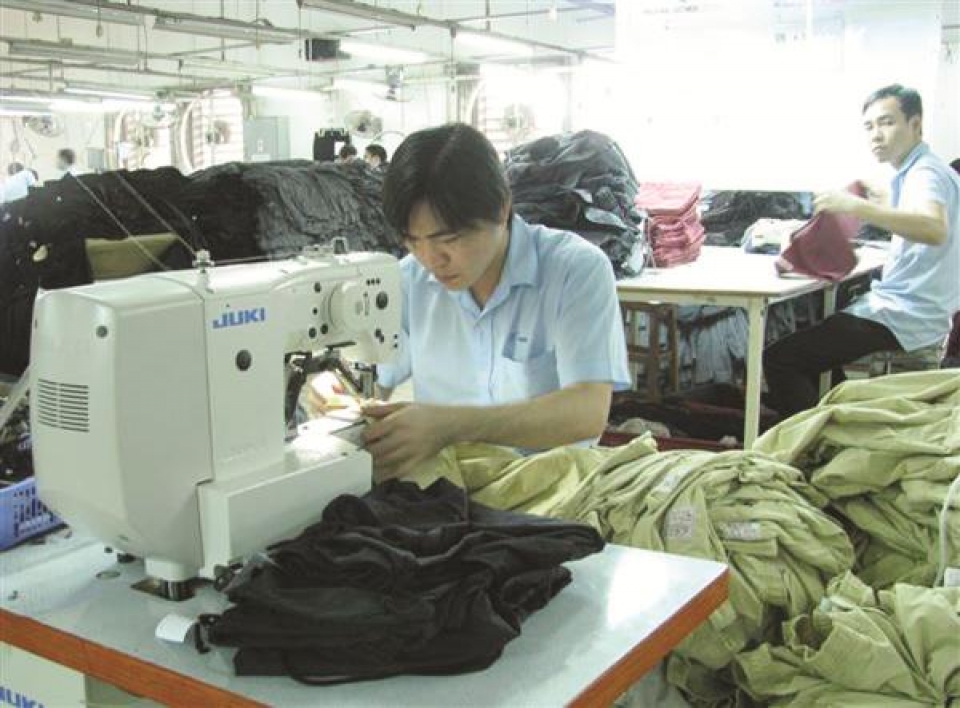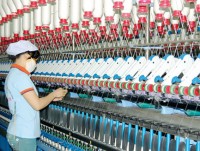Textiles and Garments: profits do not increase with revenues
| Why Vietnamese textiles industry export figures are different from Customs? | |
| “Plus points” to increase the competitiveness of textile exports. | |
| VN garment sector faces rough 2017 |
 |
| Textiles and garments manufactured for export at Sai Gon 3 Garment Joint Stock Company |
Revenues increased, profits decreased
In 2016, the net revenues of Thanh Cong Textile Garment Investment Trading JSC (TCM) rose by 10%, reaching 3,070 billion vnd. However, after-tax profit decreased by 25%, reaching only 114 billion vnd. Compared to the plan set in early 2016, the revenues and profits of TCM reached 94% and 72% respectively. According to the analysis of Vietcombank Securities Co., Ltd, the growth in net revenues of TCM in recent times mainly came from additional revenue contribution of Vinh Long factory and revenue from exports by increases in exchange rate of the USD against VND. However, the after-tax profits plunged due to difficulties in the fiber field.
In addition, the output price of fiber did not increase while raw cotton prices began to sharply increase from March, 2016 due to the failure of crops of major cotton export countries in Pakistan and India. Therefore, the profits of this field were still at low level of about 2% (compared to the previous same quarter of 6%). In addition, Vinh Long factory went into operation from July, 2015, thereby the TCM depreciation expense in 2016 sharply increased by approximately 24% compared to 2015.
Similarly, at the Century Synthetic Fiber Corporation (STK), in the fourth quarter of 2016, the company achieved to 411 billion vnd of revenue, nearly four times higher than same quarter of 2015. However, costs of goods sold also increased to 335%, the gross profits were nearly 31 billion vnd, up by 18% compared to the fourth quarter of 2015. After deducting expenses, STK had a net loss of 14 billion vnd against a profit of nearly 10 billion vnd in the same quarter of 2015. According to the explanation of Mr. Dang Trieu Hoa, Director General of STK, though the revenues sharply increased, the selling price in the fourth quarter of 2016 of the Company was about 9% lower than in the same quarter of 2015 due to the weak demand, excess supply and competition and dumping of Chinese companies in the domestic market and global markets. Meanwhile, the costs of production as raw materials, electricity, labor costs and management costs during the quarter did not decrease compared to 2015.
Moreover, the company was burdened with loan interest and provision for exchange rate differences increased over the same quarter of 2015. In particular, the financial cost of the fourth quarter of 2016 of the STK was 21 billion vnd, nearly double compared to the fourth quarter of 2015. Accumulating the whole of 2016, the STK after-tax profits were only 25 billion vnd, sharply decreased compared to the profits of 71 billion vnd of 2015.
Similarly, the revenues of the fourth quarter of 2016 of the G.Home Textile and Garment Investment JSC rose by 14%, reaching 96 billion vnd, but their after-tax profits declined by 32%, only reaching 1.7 billion vnd. According to Mr. Nguyen Hach, President of G.Home Management Board, the costs the company in the quarter sharply increased compared to the same quarter last year. Specifically, the financial costs increased by 30%, the cost of company management increased by 59% and other costs also increased by 45%. These caused a decrease in the company’s profits compared to the same quarter last year. Mr. Hach expected that the G.Home profit rate will be improved in 2017 when the Company enhanced sale of products with value increases such as recycled fiber and the market prices are gradually retrieved due to the balance of demand and supply being gradually improved
Meanwhile, at the Binh Thanh Imp-Exp Production and Trade Joint Stock Company (GIL), the revenues of the fourth quarter of 2016 of reached 260 billion vnd, down by 12% compared to the fourth quarter of 2015; the after-tax profits were minus 1.7 billion vnd against the profits of nearly 19 billion vnd in the same quarter of 2015. According to Director General of the GIL, Le Hung GIL, in the quarter, the high-value orders were not transferred. Also the company also suffered from damages due to exchange rate fluctuations. Specifically, financial costs in the fourth quarter of 2016 of GIL were 34.5 billion vnd, increased 3 times compared to the same quarter of 2015.
Advantages were gradually lost
According to analysis of the Maritime Securities Incorporation (MSI), the competition in the textile and garment industry is becoming increasingly fierce. Vietnam textile and garment enterprises are facing great competitive pressures from major exporting countries such as Cambodia, Bangladesh, India, and China, when these countries are getting incentives from their Governments, especially the policy on weak exchange rate against the USD to develop the textile and garment industry and attract orders, besides, the costs of processing in the garment industry of these countries have not increased for in the recent three years.
Besides, Vietnam is also losing the advantage of cheap labor costs. Only from the period 2008-2016, the minimum regional wage for domestic enterprises has increased on average by 26.4% per year and for FDI enterprises increased by 18.1% per year. From July 1, 2017 to now, the minimum regional wage continues to increase from 2.58 million vnd to 3.75 million vnd per month for employees. This will cause many pressures for the textile and garment industry due to the high decrease of cost of social insurance and health insurance thereby the product prices are higher than prices of competitors. In 2016, the traditional textile and garment customers of Vietnam have gradually tended to move their orders to countries with lower production costs, such as Myanmar, Cambodia, and India. These countries have no regulations on annual increase of minimum wage and the rate of insurance premium is lower at about 18% (while the rate in Vietnam is 22%).
 | In innovation, Vietnam said to be losing competitive edge The competitive edge of the Vietnam domestic economy has eroded sharply over the last year, since the ... |
In addition, most Vietnam exporting enterprises exporting to the EU, US and Japan use the USD. Currently, the USD has appreciated against the Euro and JPY, especially after the FED raised interest rates. Meanwhile, the rate of the VND against the USD was unchanged in 2016 in accordance with the policies to stabilize the exchange rate of the Government, making the prices of Vietnam textile and garment products in these markets more expensive and less competitive.
Related News

The trend of international business expansion of enterprises
08:54 | 11/08/2024 Import-Export

Businesses are "thirsty" for labor when orders flourish
15:25 | 04/08/2024 Headlines

Businesses focus on building brands and increasing profits
10:05 | 04/07/2024 Headlines

Businesses focus on building brands in addition to increasing profit
10:40 | 26/06/2024 Import-Export
Latest News

Increasing opportunities for exporting agricultural products to China by rail
15:31 | 05/11/2024 Import-Export

Monthly aquatic exports top 1 billion USD again after 2 years
15:00 | 05/11/2024 Import-Export

EU partners no longer 'lenient', Vietnam must adapt through ESG policies
09:02 | 05/11/2024 Import-Export

Changes in Canada's trade defense laws
09:00 | 05/11/2024 Import-Export
More News

Import and export are expected to reach 800 billion USD
13:32 | 04/11/2024 Import-Export

Fresh coconuts quenching new overseas markets
13:29 | 04/11/2024 Import-Export

Rice exports likely to set new record in 2024
13:25 | 04/11/2024 Import-Export

Vietnamese goods conquer halal market through trust and quality
09:57 | 04/11/2024 Import-Export

Exporters urged to have strategies to take advantage of UKVFTA for expansion
17:33 | 03/11/2024 Import-Export

Fresh coconuts quenching new overseas markets
17:29 | 03/11/2024 Import-Export

Vietnam and UAE trade sees billion-dollar growth
07:15 | 03/11/2024 Import-Export

Sharing responsibility for ensuring security and safety of the supply chain
07:13 | 03/11/2024 Import-Export

Many factors affecting tuna exports in the last months of the year
19:38 | 02/11/2024 Import-Export
Your care

Increasing opportunities for exporting agricultural products to China by rail
15:31 | 05/11/2024 Import-Export

Monthly aquatic exports top 1 billion USD again after 2 years
15:00 | 05/11/2024 Import-Export

EU partners no longer 'lenient', Vietnam must adapt through ESG policies
09:02 | 05/11/2024 Import-Export

Changes in Canada's trade defense laws
09:00 | 05/11/2024 Import-Export

Import and export are expected to reach 800 billion USD
13:32 | 04/11/2024 Import-Export





